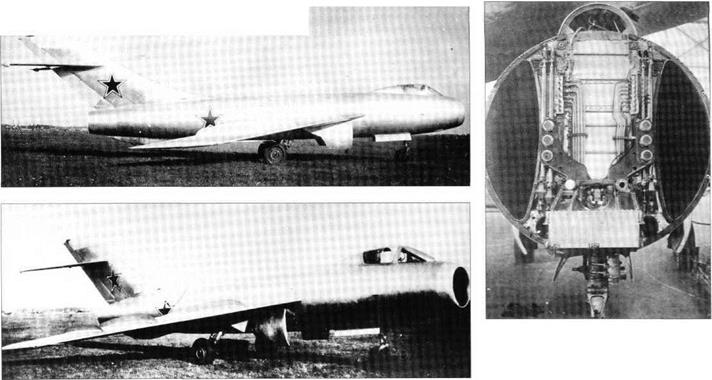Sukhoi Su-17, R
Purpose: To exceed Mach 1 and possibly serve as the basis for a fighter.
Design Bureau: P O Sukhoi, Moscow.
Note: this aircraft was not related to later aircraft with the same designation.
In late 1947 the Council of Ministers issued a plan for 1948-49 calling for the construction of new experimental aircraft. One type was to research high-subsonic, transonic and low supersonic speeds, and also if possible provide the basis for the design of a supersonic tactical fighter. Contracts were issued to Yakovlev (Type 1000) and Sukhoi (Aircraft R). In each case funds were provided for one flight article and one static test specimen, and Sukhoi’s design proceeded rapidly. From the outset provision was made for two heavy cannon, and in 1949 the WS designation Su-17 was issued. As early as July 1949 the flight article was taken to LIl-MAP at Zhukovskii, where the assigned pilot, Sergei Anokhin, carried out increasingly fast taxi tests. Just as he was about to make the first flight the Su-15 radar-equipped interceptor suffered violent flutter and crashed, Anokhin ejecting. Rather precipitately, CAHI (TsAGI) blamed Sukhoi, and moreover claimed that the wing of Aircraft R was also torsionally weak and would flutter at high airspeeds. CAHI therefore refused to issue flight clearance for this aircraft. In turn this led Stalin to order that Sukhoi’s OKB should be liquidated on 1st November 1949. It was reopened in 1953 after Stalin’s death.
This outstanding design was made possible by the rapid development of the powerful TR-3 (later called AL-5) afterburning axial turbojet by A M Lyul’ka, qualified in January 1950 at4,600kg (10,141 Ib), with a dry rating of 4 tonnes (8,8181b). Had the Su-17 continued it would certainly have later flown with more powerful Lyul’ka engines. The propulsion system was ‘straight through’ from the plain nose inlet, which immediately divided to pass each side of the cockpit, to the tail. Amid
ships, at Frames 15/15A and 20/20A, the main wing spars passed through at mid-level. The wing had CAHI (TsAGI)-9030 profile at the root, changing to symmetric SR-3-12s at the tip, the!4-chord sweep being 50°. Above each wing were two full-chord fences plus another from the leading edge to the aileron. Three tracks carried each of the Fowler-type flaps. High on the large vertical tail was mounted the fixed tailplane, again with 50° A-chord sweep and ground adjustable over the range ± 1.5°. The port aileron and starboard elevator had tabs, and the rudder had a section of ‘knife’ (thin strip behind the trailing edge). This aircraft pioneered Soviet use of hydraulically boosted flight controls, on all axes. All units of the landing gear had levered suspension, using high-pressure shock absorbers pioneered on the Su-15, and retracted into the fuselage. The nose unit had a 530 x 230mm tyre and retracted to the rear, while each main unit had an 800 x 225mm tyre and pneumatic plate brake and retracted forwards about a skewed axis under the wing root, to be covered by a large door. The ventral bulge under the tail had a steel underside and made provision for housing a cruciform braking parachute. On each side of the rear fuselage was a door-type airbrake, opened to 60°, which like the flaps, landing gear and flight controls, was operated by a hydraulic system at what was then a new high pressure of 211kg/cm2 (207-MPa, 3,000lb/in2). The cockpit was pressurized, maintaining 0.65kg/cm2 (9.2 lb/in2) up to 7km (22,966ft) and holding a constant dp of 0.3kg/cm2 (4.3 lb/in2) above that level. Like several previous Soviet aircraft, the pilot’s ejection-seat was mounted in a nose section designed to separate from the fuselage in an emergency. The planar joint, sealed by an inflatable ring, sloped forward to avoid the nose-gear, and it could be broken by firing a cordite charge at the bottom joint, allowing the nose to pivot and separate from the two upper connections. Separation was triggered automatically if vertical accelera
tion reached ± 18 g, or under pilot commcind. The separated nose streamed a drogue which after a delay extracted the main ribbon parachute. The pilot could then eject, experiencing a maximum of 5 g. The pilot could also eject normally, from the intact aircraft, but only after jettisoning the sideways-hinged canopy. A total of 1,219 litres (268 Imperial gallons) of fuel was housed in the fuselage, there being one metal and two bladder tanks behind the cockpit and three metal tanks (one a toroidal hollow ring) around the jet- pipe. Provision was made for a jettisonable 300 litre (66 Imperial gallon) tank to be scabbed under each wing, and for two N-37 guns, each with 40 rounds, to be mounted in the fuselage. The avionics were comprehensive, including vhf, radio compass, an IFF transponder and precision radio altimeter.
There is no reason to doubt that this aircraft would have been most valuable, and preventing it from flying appears in retrospect to have been a serious error. The Soviet Union suffered from its thoughtless precipitate actions.
|
Dimensions Span Length Wing area |
9.6m 15.253m 27.5 rrf |
31 ft 6 in 50 ft ‘A in 296 ft2 |
|
Weights |
||
|
Empty |
6,240kg |
13,757 Ib |
|
Loaded |
7,390kg |
16,292 Ib |
|
Performance (estimated) |
||
|
Max speed, at sea level |
l,252km/h |
778 mph (Mach 1.022) |
|
at 10 km (32,808 ft) |
1,152 km/h |
716 mph (Mach 1.08) |
|
Time to climb to 10km |
3.5 min |
(32,808ft) |
|
Service ceiling |
15.5km |
50,853 ft |
|
Range (internal fuel at 10 km cruising at 830 |
km/h, 516 mph) |
|
|
550 km |
342 miles |
|
|
Take-off run |
450m |
1,476ft |
|
Landing speed/ |
194 km/h |
120.5 mph |
|
run |
660m |
2,165ft |
|

|
|
|











